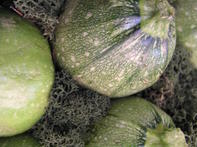
Propagation
Propagation of courgettes is from seed.Planting Method
Courgette planting can be by direct seeding or by producing seedlings in the winter and when the conditions are right planting these out into the fields. Planting seedlings gives more certainty of plant density on the land and also wins time allowing for earlier harvesting.Spacing
Courgettes should be spaced 50 cm apart in rows that are 100 cm apart. A good stand of courgette plants is between 10 000 and 15 000 plants per hectare. Seeds are planted five to seven centimetres deep.Sowing Time
For direct seeding, this can be done as soon as the last winter frosts have passed. If courgette seedlings are prepared indoors in a greenhouse then this can start in July and after four to five weeks they can be planted out immediately after the last frost, this will result in an earlier production.Planting Time
Courgettes are most commonly planted in early spring from August to the beginning of November. They can also be planted throughout the year in areas where temperatures do not exceed 30°C for long or do not experience frost in the winter months.Growth Period
From the planting of seeds to when the first baby courgettes can be harvested is normally eight to ten weeks. Thereafter continual harvesting at least twice per week promotes the development of flowers and fruit and harvest can continue for a further six weeks.Fertilization
Before planting, the best practice is to have soil samples taken and analyzed and get recommendations from the local extension officers and agronomists for fertilizer requirements for courgettes.
A good average nutrient recommendation is the following: for the first fertilizer application when planting seedlings, apply 350 to 400 kg of 3:1:5 (26) or other potassium-rich NPK mixture immediately before planting and incorporate this into the topsoil of the plant rows.
This is then immediately available to the plant after planting. When direct seeding is done, this first application of fertilizer will be broadcast along the plant rows when the plants have emerged and are about 5 cm to 10 cm tall. About 3 to 4 weeks after the first application, a second application of the same as the first can be applied by broadcasting along the plant rows.
If drip irrigation is used then these applications can be fed through with the water. Liquid fertilizers are normally spread over four or five applications throughout the growing season.
It is better not to use too much nitrogen as this will promote growth of foliage rather than flower production as in the case with higher potassium mixtures.
Irrigation
Courgettes can be irrigated by overhead sprinkler irrigation but many commercial growers are moving to drip irrigation as this saves water and allows for more accurate water and nutrient supply to the plant.
Free water on the leaves and flowers from sprinklers hamper pollination and promotes fungus and decay. Courgette roots are quite shallow making the plants sensitive to moisture stress. It is therefore advisable to irrigate at least twice per week to ensure the soil remains at optimum moisture content to eliminate stress.
Normally ±30 mm of irrigation per week, divided into two applications of 15 mm each should be sufficient but if the temperature increases it could be necessary to increase this.
It is advisable to monitor the soil moisture continuously by hand using a spade or augur or by installing moisture tension meters throughout the production area. The imperative is to avoid water stress rather than to rectify as by then the damage has been done to the crop.
By Louise Brodie